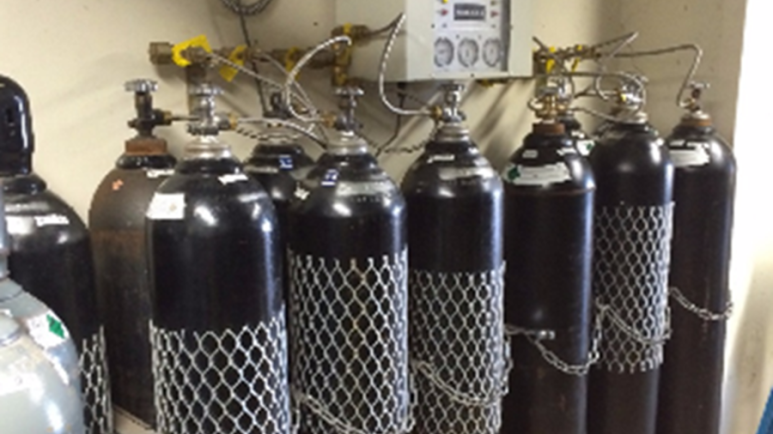
Editor’s Note: This post was originally published in March 2016 and has been updated for accuracy and comprehensiveness.
A manifold is a way to connect a group of cylinders of compressed gas to a control mechanism and then to a distribution system. Each cylinder connects through a hose or flexible tubing to a common pipe that usually will go to a control valve or valves for control and metering before being released to the application for the gas. In a hospital setting, nitrogen, nitrous oxide, and CO2 may come from a group of cylinders to be piped to areas in the building.
Based on this definition, you may think the cylinders that provide medical gases are completely filled with gas. But this is a common misconception.
Misunderstanding of CO2 and Nitrous Oxide Cylinder Manifolds
The Liquid/Gas Mix
Many people do not realize that carbon dioxide and nitrous oxide tanks are approximately 70% liquid. This fluid is a liquidized version of the gas. Since almost all medical applications require these compounds in gaseous form, the liquid must boil or vaporize before using it for its intended purpose.
Not only must the liquid turn to vapor, but the transformation must happen at a rate that allows for sufficient usage.
Rates of Withdraw
When withdrawing gas from a cylinder, there are factors that must be considered.
One factor is the flow rate of a gas or a liquid. This is measured by SCFM, or Standard Cubic Feet per Hour.
The industry standard flow rate from a standard-size cylinder with a maximum temperature of 70 degrees F is 50 SCFM. It is vital to maintain this rate of withdrawal for safe facility operations.
The number of cylinders in the manifold is another factor that can influence the amount of gas extracted from the tank. The number of cylinders in a manifold is directly proportional to the amount of gas that can be released at a given time.
Ambient temperature is the temperature of the area surrounding an object. This temperature is directly related to the rate the gas can be withdrawn from a cylinder. As the ambient temperature changes, so does the flow of gas. If the ambient temperature rises or drops, the flow of gas will follow suit.
Historically, carbon dioxide and nitrous oxide cylinders could not be installed in areas with an ambient temperature that could fall below 20 degrees F. This changed with the 2012 edition of the NFPA code handbook, which allowed cylinder manifolds to be installed in areas where the ambient temperature may fall to -20 degrees F.
Heaters and Rate of Flow
Another misunderstanding or common misconception is the "heaters found in the manifold headers or the manifold cabinet can affect the rate of gas flow." The heaters primarily serve to prevent the freezing of the primary regulators.
Regulator freezing can occur when the gas decompresses and becomes colder. This may cause ice crystals to form in the orifices when there is a high flow of gas. Think of using a CO2 fire extinguisher and the snow it makes. For example, if gas enters a regulator with an ambient temperature of 70 degrees F, the temperature of the gas could chill or decrease to as low as -30 degrees F.
If not supervised, heaters can also present safety issues as they have been found to cause the surface temperatures of manifold piping to become extremely hot. Heater designs do vary. Some systems with large draws may have a second bank of cylinders to draw from in an emergency or when the demand would cause icing.
Pressure and Gas Flows
An increase in ambient temperature has been shown to increase cylinder pressure. This factor can be illustrated by looking at the pressure of nitrous oxide at 70 degrees F. The pressure at this temperature is 745 PSIG (Pounds per Square Inch Gauge) but rises significantly higher as the ambient temperature increases. At 100 degrees F, the cylinder pressure has been recorded as high as 1,000 PSIG.
A drop in ambient temperature can subsequently decrease the pressure in a cylinder. An N20 cylinder with an ambient temperature of 20 degrees F has a pressure reading of 400 PSIG. When the temperature drops to -20 degrees F, the pressure decreases to 200 PSIG. Knowing these fluctuations, cylinders must be sheltered from any outdoor elements, whether direct heat or freezing temperatures.
Conclusion
For the safest, most efficient performance of your cylinder manifold, have the system installed in a climate-controlled area that has adequate shelter from the elements and tested on a regular schedule.
The biggest misunderstanding regarding N20 and CO2 cylinder manifolds is that the cylinders connected to the manifold are more gas than liquid, and their weight can shift and slosh when moved and freeze if evacuated too fast.
At CHT, we continue to provide innovative technology solutions that help facilities strive for a simple, safe, and secure way to manage healthcare compliance and patient safety. Reach out to a CHT technician to learn more about the inspection, testing, or maintenance of your medical gas systems.




